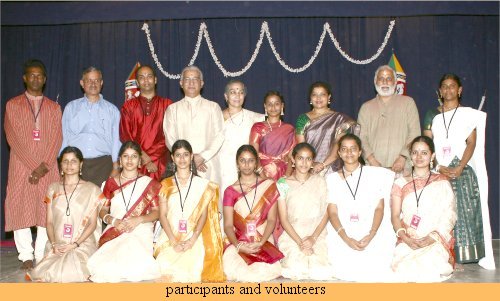 |
 |
The nuances and myriad concepts of naatya were shared in the city by stalwarts in the field of Bharatanaatyam and Kuchipudi. Very well organised jointly by Divyanjali Institute of Bharatanatyam, of Divyasena, and Gana Mukundapria, a lecture-demonstration on Naatya-kala was held at the Dakshinamurthy Hall, Chennai. The lecture was delivered by Bharatanaatyam exponent / Natyaacharya V P Dhananjayan and Kuchipudi artiste Kishore Mosalikanti a worthy disciple of Guru Vempati Chinna Sataym.. With an aim to enlighten young learners of art with the richness of art and culture, the event saw a fair mix of the young and old. In fact, the youngsters seemed to form the majority. “This is definitely a good sign,” said Dhananjayan. The concept of Naatya, as specified by Dhananjayan, has been treasured and carried through generations. Unlike many such events in the city, strangely the hall was full with enthusiastic youngsters.
While elaborating on the terminology of various aspects of Naatya presentations, he disapproved of young teachers prefixing their names with ‘Guru’ which has a profound and in-depth meaning and significance to it. He literally pleaded with Bharatanaatyam artistes not to misuse the word 'Guru' which got the approval of the audience with laud applause. Dhananjayan went on to instill another thought that is new, yet old. "Ours is the only country that shares its name with its performing arts – Bharatham and Bharatanatyam," he said. This is indeed an identity that we all need to be proud of. "Certain practices in our tradition do have a lot of scientific explanations. It is our identity and we must be proud of it because they are value-based," he said. He said wearing a 'tilaka' on the forehead is not a religious mark, but a custom evolved with scientific significance. He wondered why our children are made to feel afraid or shy away from practicing our customs and the need to feel proud of our identity. Such value-based practices became the basis for true education. "Initially, great gurus taught students from the knowledge they acquired through their family life and experiences. Swabhava shudhi (good conduct) was inculcated by these teachers of great repute. Naatya is in itself a medium of true education, and with physical, mental and spiritual combination, this form becomes the best method of teaching and learning," he said, "because spiritual discipline is most necessary for one's growth." About music that goes in line with Naatya, he said, "Knowledge of music is necessary for an artiste because any Bharatanaatyam performance requires the main artiste to dominate the musicians and not the other way around." Youngsters today are keener on getting on to stage rather than perfecting their art. Well. "Anga Shudhi means the perfection of body line and body movements is like 'suswaram’ (perfect note) in music concerts. If this is not perfect, an artiste must never get on stage," he said. "If an artiste is qualified enough to get on stage, the selection of items, costume, jewellery, etc, must befit the artiste according to her age and appearance." As he concluded his lecture, Dhananjayan made a suggestion for future artistes and performances, "Just as musicians have mikes to amplify their music, artistes could make use of multimedia to project their performance on screen simultaneously to reach out to the audiences sitting in the very last row."  In the 13th century there was a young man named Siddhappa whose marriage was arranged to a beautiful girl. Unfortunately while crossing the river to attend his wedding, his boat capsized and he was on the verge of being drowned. He pleaded with God to save him and promised to dedicate his life to the service of God. Miraculously he was saved, and on that day, he was re-born as Siddhendra Yogi. He wrote a drama in praise of Sri Krishna and gathered male dancers to perform the same. "Kuchipudi was initially male-dominated and the first dance drama was called the Bhaama Kalapam." He performed a short portion of the same drama. "This art form always had an item where the artiste enters the stage introducing the character," he said. This is called 'Paathra Pravesha Daru'. As he performed an item to explain it, the audience enjoyed it better. Since Kuchipudi naatya is still evolving, Mosalikanti concluded his demonstration with an experimental presentation of a varnam using a 'tharangam' – the plate that is an important part of Kuchipudi. At the end
of three hours, the audience was left with much knowledge to treasure for
long. Most of them urged Divyasena to organise more such events for the
benefit of all lovers of naatya.
Prathibha Raman is a trainee in journalism and a Bharatanatyam student. |